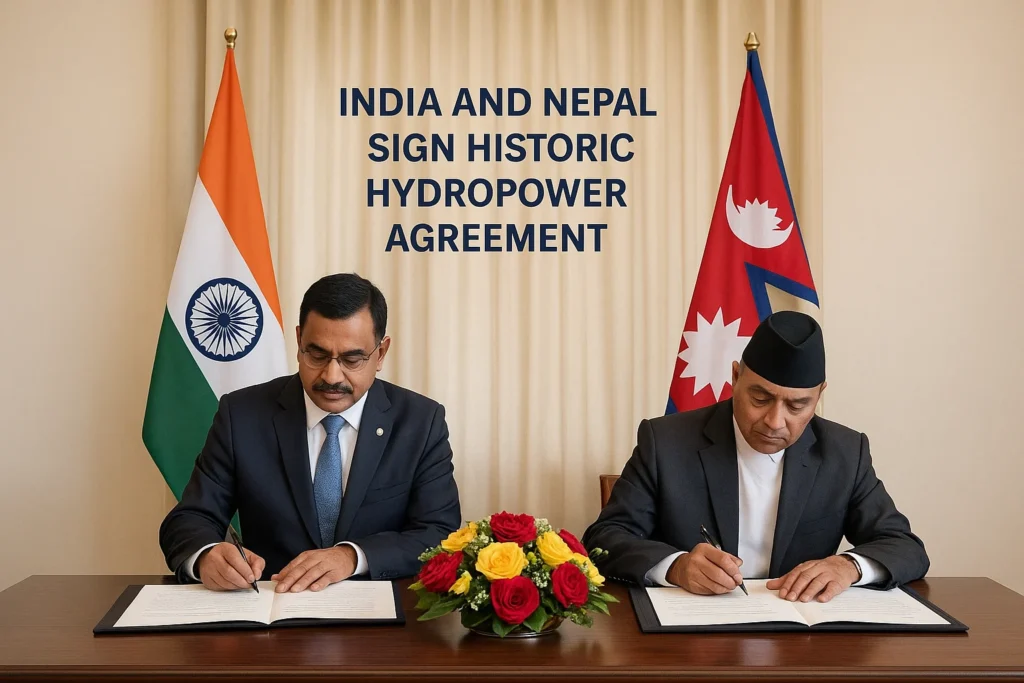The Himalayas stand as Earth’s most majestic mountain range, a silent witness to civilizations rising and falling across millennia. These snow-capped peaks, often called the Third Pole, contain the largest freshwater reserve outside the polar regions. From these frozen reservoirs emerge mighty rivers that carve through rock and time, nourishing valleys and sustaining hundreds of millions across South Asia. For Nepal, nestled amidst these mountains, these rivers represent more than geographical features—they form the very source of national identity, cultural backbone, and untapped potential.
Yet despite their power, these rivers have whispered promises largely unfulfilled. They contain immense clean energy potential—a sleeping giant of economic opportunity. Meanwhile, to the south, India undergoes one of history’s most remarkable transformations. As a nation of breathtaking scale and dynamism, its booming economy creates insatiable energy demands. Cities expand, industries grow, and homes light up—all requiring power that must increasingly come from sustainable sources to ensure a healthier planet.
Two neighboring nations, bound by geography yet separated by complex histories. One possesses vast untapped resources. The other possesses vast growing needs. For decades, the puzzle pieces remained visible yet unconnected, hampered by missed opportunities and historical cautiousness.
This narrative has now fundamentally changed. The recent landmark agreement between India and Nepal on cross-border hydropower development represents far more than diplomatic achievement—it marks a watershed moment in South Asian cooperation. This pact signifies a profound commitment to partnership, pledging to harness Nepal’s roaring rivers to illuminate homes, fuel industries, and forge unbreakable bonds of mutual prosperity. This is the story of that promise—its origins, mechanics, immense potential, and the path forward.
The Geological Marvel: Understanding Nepal’s Hydropower Landscape
Nepal’s topography creates perfect conditions for hydropower generation. The country features dramatic elevation changes, from the lowland Terai plains at approximately 100 meters above sea level to the towering Himalayas exceeding 8,000 meters. This steep gradient, combined with abundant water sources, creates exceptional energy generation potential.
The river systems originate from multiple sources: Himalayan glaciers provide perennial flow through gradual melting, while monsoon rains between June and September contribute massive seasonal discharge. This combination ensures relatively consistent water availability throughout the year, with monsoon periods providing surplus water that can be stored in reservoirs for dry season use.
The three major river systems—Koshi, Gandaki, and Karnali—offer numerous sites for development. Each basin possesses unique characteristics:
- The Koshi River basin, draining the eastern Himalayas, offers potential for both storage and run-of-river projects
- The Gandaki system, flowing through central Nepal, features deep gorges ideal for high-head projects
- The Karnali in western Nepal represents the longest river system with the largest potential for storage projects
These geographical advantages position Nepal as a potential hydropower powerhouse for South Asia.
The Sleeping Giant: Nepal’s Energy Poverty Despite Abundant Resources
Paradoxically, despite its enormous potential, Nepal has experienced severe energy poverty throughout its modern history. The term “load-shedding” became embedded in the national vocabulary—referring to scheduled power cuts that sometimes exceeded 16 hours daily.
The consequences extended beyond inconvenience:
- Industries operated at reduced capacity or relied on expensive diesel generators
- Students studied by candlelight and kerosene lamps
- Healthcare facilities faced challenges maintaining essential services
- Economic growth was significantly constrained by energy shortages
This energy deficit represented both a national embarrassment and a development crisis. The gap between potential and reality stemmed from multiple factors:
- Limited domestic capital for large-scale infrastructure development
- Technical challenges of building in difficult mountainous terrain
- Political instability affecting long-term planning
- Limited cross-border energy infrastructure
The situation created a powerful imperative for finding solutions that would unlock Nepal’s hydropower potential.
India’s Energy Landscape: Growth, Challenges and Transition
India’s energy needs reflect its extraordinary scale and pace of development. As the world’s third-largest electricity consumer, its power requirements have grown exponentially alongside economic expansion and rising living standards.
The country faces a complex energy trilemma:
- Ensuring energy access for all citizens
- Maintaining affordable electricity prices
- Transitioning toward sustainable energy sources
India has made remarkable progress in renewable energy deployment, particularly solar and wind power. However, these variable energy sources require balancing through dispatchable power—electricity that can be generated on demand to maintain grid stability.
Conventional hydropower provides this crucial grid stability function while producing minimal emissions. However, new domestic hydropower development faces challenges:
- Environmental concerns regarding ecological impacts
- Social challenges related to community displacement
- Geological constraints in suitable locations
- Lengthy development timelines
These factors made cross-border energy cooperation increasingly attractive from both energy security and economic perspectives.
Historical Context: The Long Road to Cooperation
India-Nepal energy cooperation has evolved through distinct phases characterized by changing approaches and attitudes.
The early years (1950s-1970s) saw initial cooperation through the Koshi and Gandak agreements. These pioneering projects focused on irrigation and flood control while including power generation components. Though groundbreaking for their time, they generated mixed perceptions in Nepal, with some viewing them as favoring Indian interests.
The middle period (1980s-2000s) witnessed Nepal seeking to develop its resources independently or with international partners. Projects like Arun III, initially backed by the World Bank, became emblematic of the challenges of this approach—facing delays due to environmental concerns, political instability, and funding issues.
The modern era (2010s-present) has seen a pragmatic reorientation toward partnership. Confidence-building measures like cross-border transmission infrastructure enabled initial power trading. The Power Trade Agreement (2014) created a framework for commercial electricity exchange. Successful implementation of projects like the 900 MW Arun III, developed with Indian investment, demonstrated the viability of cooperation.
This evolutionary process reflects a learning curve on both sides, moving from skepticism toward recognition of mutual benefit.
The Agreement Framework: Architecture of Cooperation
The recent agreement establishes a comprehensive framework for collaboration built on several key pillars:
Joint Development Model
The partnership emphasizes joint ventures between Indian public sector undertakings (like NHPC and SJVN) and Nepal’s Electricity Authority. This model features:
- Shared equity investment
- Collaborative technical execution
- Joint risk management
- Mutual benefit sharing
This approach represents a significant evolution from earlier models, positioning Nepal as an equal partner rather than merely a resource provider.
Power Sharing Principle
A fundamental principle ensures that Nepal’s energy security receives priority:
- All generated power first fulfills domestic Nepali demand
- Only surplus electricity is exported to India
- Nepal maintains control over its energy destiny
This “Nepal First” approach addresses historical concerns about resource exploitation.
Multi-Project Approach
The agreement encompasses multiple projects at different development stages:
- Pancheshwar Multipurpose Project (6,480 MW)
- Upper Karnali Hydroelectric Project (900 MW)
- Arun IV Hydroelectric Project (695 MW)
- Phukot Karnali Hydroelectric Project (480 MW)
This portfolio approach diversifies risk and creates multiple cooperation pathways.
Financial Arrangements
The framework includes innovative financing mechanisms:
- Mixed financing from both governments
- International financial institution participation
- Public-private partnership components
- Long-term power purchase agreements
These arrangements ensure financial viability while distributing risk appropriately.
Technical Innovations: Engineering in the Himalayas
Developing hydropower in the Himalayan region presents extraordinary engineering challenges requiring innovative solutions.
Geological Considerations
The young, fragile Himalayas present unique challenges:
- Seismic activity requiring earthquake-resistant design
- Complex rock mechanics necessitating specialized tunneling techniques
- Glacial lake outburst flood (GLOF) risk mitigation
- Sediment management strategies
Climate Resilience
Projects incorporate climate adaptation features:
- Revised hydrological models accounting for glacial melt patterns
- Reservoir operations adaptable to changing precipitation patterns
- Infrastructure designed for extreme weather events
Modern Construction Techniques
Innovative methods address accessibility challenges:
- Advanced tunnel boring machines for headrace tunnels
- Remote sensing and GIS for optimal site selection
- Prefabricated components for difficult terrain transport
- Automated monitoring systems for structural integrity
These technical innovations enable project development while minimizing environmental and social impacts.
Environmental Considerations: Balancing Development and Conservation
The agreement recognizes the exceptional ecological value of the Himalayan region and incorporates robust environmental safeguards.
Environmental Impact Assessment
Comprehensive assessments include:
- Biodiversity baseline studies
- Hydrological impact modeling
- Carbon footprint calculations
- Cumulative impact assessment
Mitigation Measures
Projects incorporate numerous mitigation features:
- Fish ladders and aquatic habitat preservation
- Watershed management programs
- Forest compensation planting
- Micro-hydropower for local communities
Climate Benefits
The environmental advantages extend beyond the immediate region:
- Displacement of fossil fuel generation
- Grid stability enabling higher renewable penetration
- Carbon sequestration through reservoir-linked forestry programs
- Air quality improvement through reduced coal combustion
These considerations ensure projects deliver net environmental benefits at local and global levels.
Social Dimensions: Community Engagement and Development
The human dimension of hydropower development receives significant attention in the agreement framework.
Community Consultation
The process emphasizes meaningful engagement:
- Early and continuous stakeholder consultation
- Culturally appropriate communication methods
- Grievance redress mechanisms
- Transparent information sharing
Livelihood Restoration
Comprehensive programs address economic impacts:
- Skills training for project-related employment
- Entrepreneurship development support
- Agricultural productivity enhancement
- Market access improvements
Social Infrastructure Development
Projects contribute to community development:
- Healthcare facility upgrades
- Educational institution support
- Drinking water infrastructure
- Rural electrification programs
These measures ensure local communities share in project benefits.
Economic Transformation: Beyond Electricity Generation
The partnership’s economic implications extend far beyond power sales revenue.
Macroeconomic Impact
Nepal stands to gain significantly through:
- Foreign exchange earnings from power exports
- Job creation across skill levels
- Industrial development enabled by reliable power
- Increased foreign direct investment
Sectoral Development
Reliable electricity enables economic diversification:
- Agriculture: irrigation, cold storage, processing
- Manufacturing: competitive production costs
- Tourism: upgraded facilities and services
- Digital economy: data centers and IT services
Fiscal Benefits
Government revenues increase through:
- Corporate taxes from project earnings
- Royalties from resource utilization
- Reduced subsidies for fossil fuel imports
- Increased economic activity broadening the tax base
These economic benefits create a virtuous cycle of development and prosperity.
Regional Implications: Beyond Bilateral Cooperation
The India-Nepal partnership creates positive externalities across South Asia.
Regional Energy Security
The collaboration enhances regional stability through:
- Diversified energy supply sources
- Improved grid resilience
- Reduced energy import dependence
- Enhanced emergency response capabilities
Transboundary Water Management
The partnership advances cooperative water governance:
- Improved flood forecasting and control
- Dry season flow augmentation
- Water quality management cooperation
- Agricultural productivity enhancement
Regional Connectivity
Energy cooperation facilitates broader integration:
- Cross-border transportation infrastructure
- Digital connectivity enhancements
- People-to-people exchanges
- Cultural and educational cooperation
These regional benefits demonstrate how bilateral cooperation can create broader positive impacts.
Implementation Challenges: Recognizing the Road Ahead
Despite the agreement’s promise, significant implementation challenges remain.
Technical Hurdles
Practical challenges include:
- Remote location logistics
- Skilled workforce availability
- Technology transfer requirements
- Maintenance and operational expertise
Financial Constraints
Funding challenges encompass:
- Capital mobilization requirements
- Currency exchange risks
- Cost escalation management
- Revenue stream predictability
Governance Issues
Institutional challenges involve:
- Regulatory coordination
- Dispute resolution mechanisms
- Project management capacity
- Anti-corruption safeguards
Addressing these challenges requires sustained commitment and adaptive management.
The Path Forward: From Agreement to Reality
Successful implementation requires coordinated action across multiple domains.
Immediate Priorities
Short-term actions include:
- Detailed project report finalization
- Environmental clearance processes
- Financial closure achievement
- Contractor selection procedures
Medium-Term Actions
Implementation phase requirements:
- Community relocation and rehabilitation
- Construction activity management
- Workforce training programs
- Monitoring system establishment
Long-Term Considerations
Sustainable operation necessitates:
- Institutional capacity building
- Knowledge transfer programs
- Adaptive management frameworks
- Continuous improvement processes
This phased approach ensures systematic progress toward project objectives.
A Vision for 2040: Transformative Potential
Looking ahead, the partnership promises transformative change across multiple dimensions.
Energy Landscape Transformation
By 2040, the region could feature:
- Nepal as a net energy exporter
- Integrated regional energy markets
- Renewable energy dominance
- Universal electricity access
Economic Development Vision
Economic transformation might include:
- Poverty reduction through job creation
- Industrial diversification
- Increased agricultural productivity
- Enhanced regional trade
Environmental Leadership
The partnership could establish:
- Climate change mitigation leadership
- Sustainable development models
- Biodiversity conservation approaches
- Environmental stewardship standards
This vision represents an ambitious but achievable future for both nations.
Conclusion: A Watershed Moment in Regional Cooperation
The India-Nepal hydropower agreement represents more than energy cooperation—it signifies a fundamental shift in regional relationships. By transforming a potential source of conflict into a foundation for cooperation, the two nations have demonstrated visionary leadership.
The partnership offers lessons beyond energy development:
- The power of patient diplomacy
- The value of trust-building measures
- The importance of equitable benefit-sharing
- The potential of regional cooperation
As implementation progresses, the world will watch this ambitious partnership unfold. Success could inspire similar cooperation across other transboundary rivers globally, demonstrating how shared resources can become sources of shared prosperity rather than conflict.
The journey ahead remains long and complex, but the foundation has been laid for a transformative partnership that promises to bring light, prosperity, and unity to both nations and the broader region. The currents of Himalayan rivers now carry not just water, but the promise of a brighter future for all.




Your writing is not only informative but also incredibly inspiring. You have a knack for sparking curiosity and encouraging critical thinking. Thank you for being such a positive influence!
Your blog is a testament to your passion for your subject matter. Your enthusiasm is infectious, and it’s clear that you put your heart and soul into every post. Keep up the fantastic work!
Your blog is a constant source of inspiration for me. Your passion for your subject matter shines through in every post, and it’s clear that you genuinely care about making a positive impact on your readers.
Your writing is a true testament to your expertise and dedication to your craft. I’m continually impressed by the depth of your knowledge and the clarity of your explanations. Keep up the phenomenal work!
Thanks I have just been looking for information about this subject for a long time and yours is the best Ive discovered till now However what in regards to the bottom line Are you certain in regards to the supply
I was suggested this web site by my cousin Im not sure whether this post is written by him as no one else know such detailed about my trouble You are incredible Thanks
My brother suggested I might like this blog He was totally right This post actually made my day You can not imagine simply how much time I had spent for this info Thanks
Your blog is a testament to your dedication to your craft. Your commitment to excellence is evident in every aspect of your writing. Thank you for being such a positive influence in the online community.
I do not even know how I ended up here but I thought this post was great I dont know who you are but definitely youre going to a famous blogger if you arent already Cheers
helloI really like your writing so a lot share we keep up a correspondence extra approximately your post on AOL I need an expert in this house to unravel my problem May be that is you Taking a look ahead to see you